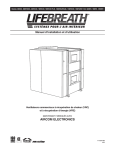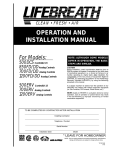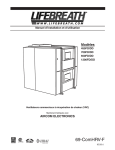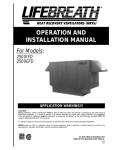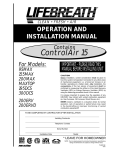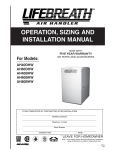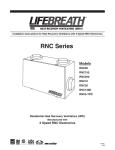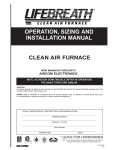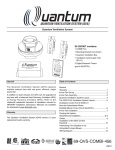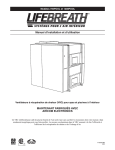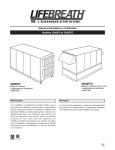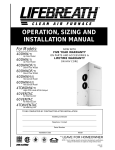Download Lifebreath 1000RHCAC Air Cleaner User Manual
Transcript
OPERATION AND INSTALLATION MANUAL For Models: 700DDPOOL 1200DDPOOL 1000RHC 1000RHCAC NOTE: ALTHOUGH SOME MODELS DIFFER IN OPERATION, THE BASIC STEPS ARE SIMILAR. CAUTION Before installation, careful consideration must be given to how the system will operate if connected to any other piece of mechanical equipment, i.e. a forced air furnace or air handler, operating at a higher static. After installation, the compatibility of the two pieces of equipment must be confirmed, by measuring the airflow’s of the Heat/Energy Recovery Ventilator (HRV), by using the balancing procedure in this manual. It is always important to assess how the operation of any HRV may interact with vented combustion equipment (ie. Gas Furnaces, Oil Furnaces, Wood Stoves, etc.). NEVER install an HRV in a situation where its normal operation, lack of operation or partial failure may result in the backdrafting or improper functioning of vented combustion equipment!!! TO BE COMPLETED BY CONTRACTOR AFTER INSTALLATION Installing Contractor Telephone / Contact Serial Number Installation Date Model * LEAVE FOR HOMEOWNER NOTE: Due to ongoing research and product development, specifications, ratings and dimensions are subject to change without notice. TI-81C 1203 Table of Contents Introduction Introduction .....................................................................2 A Heat Recovery Ventilator (HRV) is designed to provide fresh air into a building while exhausting an equal amount of stale air. During the winter months, the incoming cold fresh air is warmed by utilizing the heat recovered from the stale air before it is exhausted to the outdoors. During summer months when the indoor space is air conditioned, the Heat Recovery Ventilator will help in cooling the incoming fresh air with the stale air that is being exhausted. Technical Data - Model 700DDPOOL ............................3 Technical Data - Model 1200DDPOOL ..........................4 Technical Data - Model 1000RHC ..................................5 Technical Data - Model 1000RHCAC.............................5 Sizing Your Pool HRV......................................................6 Calculation ......................................................................7 System Installations .....................................................7 Table 1 Evaporation Rate ...............................................8 Table 2 Flowrate Factor ................................................ 9 Installation Diagram Sketch #1 ....................................10 Installation Diagram Sketch #2 ....................................11 Location for Mounting ...................................................12 The Ductwork System ...............................................12 Outside Weatherhoods ................................................13 Ducting from Weatherhoods ........................................13 Warmside Ducting - General.........................................13 Stale Air Return System ..............................................13 Fresh Air Supply System .............................................14 Various Installation Types .............................................15 Electrical Connections ...............................................16 Damper Defrost ............................................................16 Auto Self Test of Defrost Systems ................................16 Operation of the HRV..................................................17 Ducting Requirements & Mode of Operation ...............18 Speed Selection and Controls ......................................19 Hydronic Reheat Coil ....................................................19 Air Conditioning (DX) Coil ............................................19 Pitot Tube Air Flow Balancing ...................................20 Service/Maintenance ..................................................21 Motor ........................................................................... 21 HRV Core......................................................................21 Filters ............................................................................22 Duct Work .....................................................................22 Damper Motor ..............................................................22 General Maintenance ...................................................22 Troubleshooting Your HRV System...........................23 Wiring Diagram ..........................................................24 Warranty ......................................................................25 2 Model 700DD POOL SPECIFICATIONS AIRFLOWS (Each Air Stream) AIRFLOW L/s (CFM) 423 (900) MOTORS Two PSC, 3 speed single shafted, 120 VAC, 2.75 Amps each (5.5 total on high speed). HP - 1/10, 1625 RPM. Watts - total on high speed - 648. FILTERS Washable air filters in exhaust and supply air streams. BLOWERS Centrifugal type rated at 700 cfm (329 L/s) free air delivery. Each air stream has one single shafted motor driving a centrifugal blower. 378 (800) 329 (700) 5.5 HIGH HIGH SPEED 282 (600) 235 (500) MED SPEED 190 (400) LOW SPEED 143 (300) 94 (200) 42 (100) 25 (.1) 50 (.2) 75 (.3) 100 (.4) 125 (.5) 150 (.6) 175 (.7) 5.0 MED 4.7 LOW TOTAL CURRENT DRAW (AMPS) @ 120 VAC PERFORMANCE CORES Modular (2 section) patented aluminum heat recovery cores arranged for efficient cross-flow ventilation.Meets the flame spread and smoke developed classifications of the National Building Code and NFPA 90A (1993 Edition) EXTERNAL STATIC PRESSURE IN PASCALS (IN. W.C.) CONNECTION DUCT SIZES Five - 14" x 8" H (356 mm x 200 mm H). TEMPERATURE EFFECTIVENESS EFFECTIVENESS MOUNTING Unit to be set on support brackets hung by threaded rod type apparatus. (brackets and rod not provided.) CASE 20 gauge prepainted galvanized steel (G60) for superior corrosion resistance. Insulated with foil faced insulation duct liner where required to prevent exterior condensation. Drain connections; two - 1/2" (12 mm) O.D. 70% 60% 50% CONTROLS Illuminated power switch, 3 speed blower control, low voltage (24 VAC) terminals for connection of remote dehumidistat (supplied) and defrost light indicating automatic operation. NOTE: Exhaust Relative Humidity (RH) at 40% 143 (300) 190 (400) 235 (500) 282 (600) 329 (700) AIRFLOW IN L/s (CFM) DEFROST Supply bypass routes indoor air to defrost core. WEIGHT 142 lbs. (64.4 kg) SHIPPING WEIGHT 167 lbs. (75.8 kg) DIMENSIONS 700DDPOOL SUPPLY AIR FROM OUTSIDE mm (inches) EXHAUST AIR TO OUTSIDE MOUNTING POINTS CONTROLS POOL AND DEFROST AIR 356 mm (14") 165 mm (6 1/2") 165 mm (6 1/2") 356 mm (14") NOTE: Service clearance is 760 mm (30 in.) from front access doors 625 mm (24 5/8 ") 210 mm (8 1/4") 200 mm (8") SUPPLY AIR TO BUILDING EXHAUST AIR FROM POOL DRAIN CONNECTION 730 mm (28 3/4") 753 mm (29 5/8") FRONT VIEW DISCHARGE SIDE 159 mm (6 1/4") 200 mm (8") 730 mm (28 3/4") INLET SIDE WARRANTY All units conform to CSA and UL standards. All units carry a 15 year warranty on the heat recovery cores and a 2 year replacement parts warranty. DATE: ____________________________________________PROJECT: _______________________________________ MECHANICAL CONTRACTOR: _________________________________________________________________________ TI-104 3 1203 Model 1200DD POOL SPECIFICATIONS DIMENSIONS 1200DDPOOL SUPPLY AIR FROM OUTSIDE 613 (1300) 566 (1200) 8.1 HIGH 518 (1100) 378 (800) 7.1 LOW LOW SPEED 282 (600) 25 (.1) 50 (.2) 75 (.3) 100 (.4) 125 (.5) 150 (.6) 175 (.7) EXTERNAL STATIC PRESSURE IN PASCALS (in. W.C.) TEMPERATURE EFFECTIVENESS 70% 60% 50% NOTE: Exhaust Relative Humidity (RH) at 40% 235 (500) 282 (600) 329 (700) 378 (800) 423 (900) 472 (1000) 518 (1100) 566 (1200) AIRFLOW IN L/s (CFM) MOUNTING POINTS CONTROLS 263 mm 263 mm (10 3/8") (10 3/8") 172 mm (6 3/4") 200 mm (8") EXHAUST AIR FROM POOL FRONT VIEW MED SPEED 329 (700) 235 (500) NOTE: Service clearance is 760 mm (30 in.) from front access doors 759 mm (29 7/8") 7.8 MED 423 (900) 508 mm (20") DRAIN CONNECTION HIGH SPEED 472 (1000) TOTAL CURRENT DRAW (AMPS) @ 120 VAC AIRFLOW L/s (CFM) AIRFLOWS (Each Air Stream) mm (inches) EXHAUST AIR TO OUTSIDE POOL AND DEFROST AIR PERFORMANCE EFFECTIVENESS CORES Modular (3 section) patented aluminum heat recovery cores arranged for efficient cross-flow ventilation. Meets the flame spread and smoke developed classifications of the National Building Code and NFPA 90A (1993 Edition). MOTORS Two PSC, 3 speed double shafted, 120 VAC, 4 Amps each (8.1 total on high speed). HP - 1/4, 1625 RPM. Watts - total on high speed 972. FILTERS Washable air filters in exhaust and supply air streams. BLOWERS Centrifugal type rated at 1200 cfm (566 L/s) free air delivery. Each air stream has one double shafted motor driving a centrifugal blower. CONNECTION DUCT SIZES Five - 20" x 8" H (508 mm x 200 mm H). MOUNTING Unit to be set on support brackets hung by threaded rod type apparatus. (brackets and rods not provided). CASE 20 gauge prepainted galvanized steel (G60) for superior corrosion resistance. Insulated with foil faced insulation duct liner where required to prevent exterior condensation. Drain connections; two - 1/2" (12 mm) O.D. CONTROLS Illuminated power switch, 3 speed blower control, low voltage (24 VAC) terminals for connection of remote dehumidistat (supplied) and defrost light indicating automatic operation. DEFROST CONTROLS Supply bypass damper routes indoor air to defrost core. WEIGHT 191 lbs. (87 kg) SHIPPING WEIGHT 215 lbs. (98 kg) SUPPLY AIR TO BUILDING 1055 mm (41 1/2") DISCHARGE SIDE 625 mm (24 5/8 ") 508 mm (20") 159 mm (5 7/8") 200 mm (8") 1055 mm (41 1/2") INLET SIDE WARRANTY All units conform to CSA and UL standards. Units carry a 15 year warranty on the heat recovery cores and a 2 year replacement parts warranty. DATE: ___________________________________________PROJECT: _________________________________________ MECHANICAL CONTRACTOR: _________________________________________________________________________ 4 TI -121 1203 Model 1000RHC and Model 1000RHCAC SPECIFICATIONS PERFORMANCE CORES Modular (3 section) patented aluminum heat recovery cores arranged for high efficiency cross-flow ventilation. Meets the flame spread and smoke developed classifications of the National Building Code and NFPA 90A (1993 Edition). MOTORS Two PSC, 3 speed double shafted, 120 VAC, 3.95 Amps each (7.9 total on high speed). HP - 1/4, 1625 RPM. Watts - total on high speed - 848. FILTERS Washable air filters in exhaust and supply air streams. BLOWERS Each air stream has one double shafted motor driving 2 centrifugal blowers. HYDRONIC REHEAT COIL Standard built-in coil in both 1000RHC and 1000RHCAC. Rated 35,000 BTU @ 140°F, 3 US gal./min. Design temperature drop is 20°F, fluid pressure drop is 1.3 feet WG at rated flow, 3/4" fittings. CONNECTION DUCT SIZES Five - 20" X 8" H (508 mm x 200 mm H). 613 (1300) 566 (1200) 8.1 HIGH 518 (1100) 7.8 MED HIGH SPEED 472 (1000) 423 (900) 7.1 LOW 378 (800) 329 (700) 282 (600) 235 (500) 25 (.1) 50 (.2) 75 (.3) 100 (.4) 125 (.5) 150 (.6) 175 (.7) 200 (.8) TOTAL CURRENT DRAW (AMPS) @ 120 VAC AIRFLOW L/s (CFM) AIRFLOWS (Each Air Stream) EXTERNAL STATIC PRESSURE IN PASCALS (in. W.C.) TEMPERATURE EFFECTIVENESS DIRECT EXPANSION (DX) EVAPORATOR COIL (model 1000RHCAC only) Factory installed 1.5 ton DX coil, 0.875" OD suction side, 0.625" OD liquid side, built-in orifice. EFFECTIVENESS MOUNTING Two brackets under cabinet, connect to threaded rod type supports (not included). CASE 20 gauge prepainted galvanized steel (G60) for superior corrosion resistance. Insulated with foil faced insulation where required to prevent exterior condensation. Drain connections; two - 1/2" (12 mm) O.D. 70% 60% 50% CONTROLS NOTE: Exhaust Relative Humidity (RH) at 40% Illuminated power switch, 3 speed blower control, low voltage (24 VAC) terminals to connect remote controls (not included), defrost light indicating defrost/recirculation mode. 235 (500) 282 (600) DEFROST CONTROLS DIMENSIONS 1000RHC/RHCAC 423 (900) 472 (1000) 518 (1100) 566 (1200) SUPPLY AIR FROM OUTSIDE Performance data includes both reheat and DX coil installed. Note there is little change in air flow with the DX coil removed. mm (inches) EXHAUST AIR TO OUTSIDE CONTROLS 263 mm (10 3/8 ") 508 mm (20") NOTE: Service clearance is 760 mm (30 in.) 263 mm (10 3/8 ") 200 mm (8") EXHAUST AIR FROM BUILDING 378 (800) AIRFLOW IN L/s (CFM) Supply bypass damper routes indoor air to defrost core. WEIGHT 255 lbs.(116 Kg) SHIPPING WEIGHT 280 lbs.(127 Kg) DEFROST & RECIRCULATION AIR 329 (700) 1088 mm (46 3/4") DRAIN CONNECTION SUPPLY AIR TO BUILDING FRONT VIEW COIL FITTINGS 625 mm (24 5/8") 508 mm (20 ") 149 mm (5 7/8 ") 508 mm (20 ") 1055 mm (41 1/2") DISCHARGE SIDE INLET SIDE 99-101 Sixty Minute Remote Timer WARRANTY 99-130 Remote Wall Mount Dehumidistat Control 24VAC only Units carry a 15 year warranty on the heat recovery cores and a 2 year replacement parts warranty. All units conform to CSA and UL standards. NOTE: • • Hydronic reheat coil is designed to temper the ventilation air (after heat recovery) back to room temperature, and is not intended for use as a primary heating source for the space. Additional controls MUST be added to pump system (not included / not available from Nutech) feeding the coil to ensure continuous water flow through it, and prevent freezing of the coil. DX coil is designed to reduce humidity brought in from outside during ventilation. Coil MUST be connected to an outdoor condensing unit (not included) by certified trades person. Not intended as a primary air conditioning system for the space. DATE:_____________________________________________PROJECT: ________________________________________ MECHANICAL CONTRACTOR: __________________________________________________________________________ 5 TI-115 1203 Sizing your Pool Heat Recovery Ventilator Determining ventilation requirements for Indoor Pool enclosures Moisture removal capabilities In addition to the amount of air being exchanged, moisture removal depends largely on the moisture content of both the inside and outside air. The trends below outline these principles. There are two primary reasons to ventilate an indoor pool enclosure. One is to provide effective and efficient control of harmful humidity levels. The other reason is to control the Indoor Air Quality (IAQ) in the pool room enclosure. When an HRV system is adequately sized to control humidity, the IAQ will automatically be controlled for most situations. Therefore this HRV sizing guide will focus on the amount of moisture introduced into the air from the pool and the moisture removing capabilities of an HRV at various flow rates. • • • The higher the indoor relative humidity, the larger the moisture removing capabilities. The higher the indoor temperature, the larger the moisture removing capabilities The lower the outdoor temperature, the larger the moisture removing capabilities. Detailed Calculation of Total Ventilation Requirements The amount of moisture evaporated from a pool is effected by: The following charts and equations can be used to accurately size the HRV for a indoor pool application. At this time some decisions should be made with regards to: 1. Surface area of the pool 2. The water temperature 3. Indoor air temperature 4. Indoor relative humidity (R.H.) 5. The amount of activity in the pool room • Pool water temperature • Indoor air temperature • Relative humidity These short rules will help in understanding how these factors will effect moisture generation It should be noted that the construction and quality of materials used in the construction of the pool room will influence the size of HRV required. High quality windows such as triple glazed, argon filled will allow a higher indoor humidity level before condensation will occur. A pool room built with loose construction techniques will have a higher natural ventilation rate than that of a room built to higher standards. It is recommended for all applications it is assumed there is no natural ventilation. 1. Larger areas of water will evaporate greater amounts of water. (By using a pool cover the surface area of the pool will be reduced and will substantially reduce water evaporation.) 2. Higher water temperatures will increase water evaporation. The first table contains the evaporation rate of water based on the water temperature, room temperature, and room relative humidity. 3. Lower indoor air temperatures will increase water evaporation. 4. Lower indoor relative humidity will increase water evaporation. The second table contains the flowrate factor based on the indoor temperature, outdoor temperature, and room relative humidity. 5. Activities in the pool will increase the water surface area, therefore water evaporation will increase. The total ventilation rate per square foot of water surface area is the result of these calculations. The total ventilation rate is this product multiplied by the water surface area. 6 Calculation Note: As a general rule, if the water temperature is maintained at 80˚F and the pool room air temperature is maintained at 82˚F, use a factor of 1 cfm/sq ft of pool surface or .5 cfm/sq ft of room area (whichever is greater) to determine amount of ventilation required. Example: Pool surface area *Indoor design air temperature Pool water temperature 81 ˚F Relative Humidity *Outdoor design air temperature 16’ x 32’ (512 sq ft) 83 ˚F 50 % 15 ˚F * Always use design temperatures for indoor and outdoor air temperatures. Outdoor design temperatures are published by organizations such as ASHRAE. Do not us day to day temperatures for this calculation. 1. From Table 1, select the appropriate evaporation rate based on the room air temperature, water temperature, and relative humidity. Evaporation Rate = 0.052 2. From Table 2, select the corresponding flowrate factor depending on the indoor air temperature, outdoor temperature, and room relative humidity. Flowrate Factor = 21.70 3. Multiply the values obtained from step 1 and step 2 to obtain the minimum CFM required per square foot of pool surface area. Evaporation rate 0.052 X X Flowrate 21.70 = CFM / square foot of water surface area = 1.12 4. Multiply the value in step 3 by the area of the pool Area of pool 512 X X Value for step 3 1.12 = CFM = 573 System Installation It is necessary to design and size the duct distribution system for both the supply and the exhaust air streams. Proper duct design will • • • Minimize air flow requirements Ensure a comfortable environment by using reheat if required Optimize humidity control, including eliminating condensation on windows by blanketing the windows with airflow Please refer to sketch 1 and 2 for typical duct layouts. 7 TABLE 1 Evaporation Rate Indoor Relative Humidity 40% 50% 60% 40% 50% 60% 40% 50% 60% 40% 50% 60% 40% 50% 60% 40% 50% 60% Evaporation Rate lb/(sq. ft-hr.) 68 0.069 0.063 0.056 0.079 0.073 0.066 0.090 0.084 0.077 0.102 0.095 0.089 0.115 0.108 0.102 0.129 0.122 0.116 70 0.068 0.060 0.053 0.078 0.070 0.063 0.088 0.081 0.074 0.100 0.093 0.086 0.113 0.106 0.099 0.127 0.120 0.113 72 0.065 0.058 0.050 0.075 0.068 0.060 0.086 0.079 0.071 0.098 0.090 0.083 0.111 0.103 0.096 0.125 0.117 0.110 74 0.063 0.055 0.047 0.073 0.065 0.057 0.084 0.076 0.068 0.096 0.088 0.079 0.109 0.101 0.092 0.123 0.115 0.106 76 0.061 0.052 0.043 0.071 0.062 0.053 0.082 0.073 0.064 0.094 0.085 0.076 0.107 0.098 0.089 0.121 0.112 78 0.059 0.049 0.039 0.069 0.059 0.049 0.080 0.070 0.060 0.091 0.082 0.072 0.104 0.095 0.085 0.118 0.109 0.099 80 0.056 0.046 0.035 0.066 0.056 0.045 0.077 0.067 0.056 0.089 0.079 0.068 0.102 0.091 0.081 0.116 0.105 0.095 82 0.053 0.042 0.031 0.063 0.052 0.041 0.074 0.063 0.052 0.086 0.075 0.064 0.099 0.088 0.077 0.113 0.102 0.091 84 0.050 0.039 0.027 0.060 0.049 0.037 0.071 0.060 0.048 0.083 0.071 0.060 0.096 0.084 0.073 0.110 0.098 0.087 86 0.047 0.035 0.022 0.057 0.045 0.032 0.068 0.056 0.043 0.080 0.068 0.055 0.093 0.080 0.068 0.107 0.094 0.082 88 0.044 0.031 0.017 0.054 0.041 0.027 0.065 0.052 0.038 0.077 0.063 0.050 0.090 0.076 0.063 0.104 0.090 0.077 78 81 84 87 8 90 93 0.103 TABLE 2 Flowrate Factor Indoor Relative Humidity 40% 50% 60% 40% 50% 60% 40% 50% 60% 40% 50% 60% 40% 50% 60% 40% 50% 60% Flowrate Factor (cfa-hr./lb.) -30 39.70 31.50 26.10 35.70 28.30 23.40 32.10 25.50 21.10 29.00 23.00 19.00 26.10 20.70 17.20 23.60 -25 40.20 31.80 26.20 36.10 28.50 23.60 32.40 25.70 21.20 29.20 23.10 19.10 26.30 20.90 17.20 23.80 18.80 15.60 -20 40.80 32.10 26.50 36.50 28.80 23.80 32.80 25.90 21.40 29.50 23.30 19.20 26.60 21.00 17.40 24.00 19.00 15.70 -15 41.60 32.60 26.80 37.20 29.20 24.00 33.30 26.20 21.60 29.90 23.60 19.40 26.90 21.20 17.50 24.20 19.10 15.80 -10 42.60 33.20 27.20 38.00 29.70 24.40 34.00 26.60 21.90 30.40 23.90 19.60 27.30 21.50 17.70 24.60 19.30 15.90 -5 0 18.70 15.50 43.90 34.10 27.80 39.00 30.40 24.80 34.80 27.10 22.20 31.10 24.30 19.90 27.90 21.80 17.90 25.00 19.60 16.10 45.70 35.10 28.50 40.40 31.20 25.40 35.90 27.80 22.70 32.00 24.80 20.30 28.60 22.20 18.20 25.60 20.00 16.30 5 48.10 36.50 29.40 42.30 32.30 26.10 37.40 28.70 23.20 33.20 25.50 20.70 29.50 22.80 18.60 26.30 20.40 16.60 10 51.50 38.40 30.60 44.90 33.80 27.00 39.40 29.80 24.00 34.70 26.40 21.30 30.70 23.50 19.00 27.30 21.00 17.00 15 56.20 41.00 32.20 48.50 35.80 28.30 42.10 31.40 25.00 36.80 27.60 22.10 32.40 24.50 19.60 28.60 21.70 17.50 20 63.40 44.70 34.50 53.70 38.50 30.00 46.00 33.50 26.30 39.70 29.30 23.10 34.60 25.70 20.40 30.30 22.70 19.10 25 74.90 50.10 37.60 61.70 42.50 32.40 51.80 36.40 28.10 44.00 31.50 24.50 37.80 27.40 21.50 32.70 24.10 19.00 30 95.90 58.70 42.30 75.30 48.50 35.80 61.00 40.80 30.60 50.50 34.70 26.40 42.50 29.80 23.00 36.20 25.90 20.10 35 112.78 69.62 46.60 84.08 54.75 38.60 66.18 44.71 32.53 57.46 37.32 27.77 46.85 31.63 23.99 39.10 27.20 20.83 40 129.66 80.53 50.90 92.86 61.0 41.40 71.36 48.63 34.46 64.43 39.94 29.13 51.20 33.47 24.97 42.0 45 146.54 91.45 55.20 101.64 67.25 44.20 76.54 52.55 36.40 71.39 42.56 30.50 55.55 35.30 25.95 44.90 29.80 22.30 50 163.42 102.37 59.50 110.42 73.50 47.0 47.80 31.10 23.03 55 60 81.72 56.47 38.30 78.36 45.18 31.87 59.90 37.13 26.93 28.50 21.57 180.30 113.28 63.80 119.20 79.75 49.80 86.90 60.38 40.26 85.33 47.80 33.23 64.25 39.96 27.92 50.70 32.40 23.76 243.30 124.20 68.10 127.98 86.0 33.70 24.50 68 71 52.60 92.08 64.30 42.20 92.30 50.40 34.60 68.60 40.80 28.90 53.60 74 77 9 80 83 Installation Diagrams EXPOSED WALL EXPOSED WALL EXPOSED WALL Blanket exposed windows with fresh dry air Main Stale Air Intake EXPOSED WALL HRV Min. 10’-0" Always attempt to minimize short circuiting of air streams, (supply fresh air on one side of room and exhaust stale air from opposite side of room). Typical Duct Layout Sketch #1 10 EXPOSED WALL INTERIOR WALL EXPOSED WALL Blanket exposed windows with fresh dry air Stale Air Intake EXPOSED WALL HRV Min. 10’-0" Always attempt to minimize short circuiting of air streams, (supply fresh air on one side of room and exhaust stale air from opposite side of room). Typical Duct Layout Sketch #2 11 Location for Mounting The Ductwork System The HRV must be located in a heated space where the surrounding air temperature does not fall below 60˚F (16˚C). The unit must be mounted level (horizontal) to obtain proper drainage or water from the heat exchange element and drip pans. The warranty will be void if these conditions are not met. A properly designed ducting system will allow the HRV to operate at its maximum efficiency. (Air flow will be restricted by undersized ducting, use of too many elbows, tees, bends, etc.). Always try to keep duct runs as short and straight as possible. NOTE: Fully insulated ducting with an integral vapour barrier must be used on all runs passing through unheated areas in order to avoid condensation problems and energy losses from the air steams. Typically, the HRV is positioned close to an outside wall or the roof to simplify the connections and keep the length of insulated ducting required for the fresh air intake to a minimum. All joints must be airtight, sealed and impervious to moisture. See specification sheets for each unit for exact duct sizes and location. A minimum clearance of 30 inches (76 cm) in front of the HRV is recommended to service the heat exchanger cores and the filters. The HRV may be mounted on an equipment platform providing the drain hoses are clear and there is sufficient space to open the doors for servicing. To minimize pressure drop and noise, galvanized metal ducts, properly sized, are recommended. Keep ducting as short as possible and use a minimum of elbows and tees. Connecting sections and shorter runs may be flexible ducting one size larger than the metal equivalent. Use flexible duct connectors at the HRV to avoid noise transmission. Install the drain pans in the bottom of the HRV so the drain connections protrude through the holes provided. Use drain hoses with hose clamps to connect the drain pan outlets to a floor drain or standpipe. Make sure the drain line slopes down to the outlet. If this is not possible a condensate pump will be required for positive removal of the water. Protect the drain line from freezing. All duct joints must be secured with screws, rivets or duct sealant and sealed with aluminum duct tape to prevent leakage. HRV CABINET DRAIN SPOUT DRAIN SPOUT TAPE TEE CONNECTOR TO DRAIN Forming the “P” Trap 12 Outside Weatherhoods Stale Air Return System The weatherhoods must have built-in “bird” screen with 1/4 in (6.35 mm) minimum mesh to prevent birds and rodents from entering into the ductwork. Do not use smaller mesh as it will be very susceptible to plugging up. Gravity dampers at the vents must not be used as they will restrict air flow and often “seize up”. The preferred location of the outside weatherhoods is: • no less than 10 ft. (3 m) apart from each other • at least 18 in ( 46 cm) above snow line or ground level • away from sources of contaminants, such as automobile exhaust fumes, gas meters, garbage cans, containers, etc. • not exposed to prevailing winds, whenever reasonable possible The outside perimeter of the weatherhood must be caulked to prevent leakage into the building. The design and size of the weatherhoods or louvres chosen by the installer must allow for adequate free area. Water and snow penetration of the system is minimized when the airflow does not exceed 1000 FPM (5.08 m/s) free area velocity. The stale air return system is used to draw air from the points in the building where the worst air quality problems occur. Balancing dampers and/or adjustable grilles are recommended on all return air lines which are used during installation to help balance the “draw” from different areas of the building. Alternately, the stale air may be drawn directly from the return air duct. When this system is used, the air handler’s blower must constantly operate. The exhaust takeoff connection must be at least a 3 ft (1 m) from a directly connected HRV supply duct if both are connected to the same duct run. Static pressure of the air handlers return system should be noted and compensated for if, it is apparent that the static pressure of the return in the air handler will exceed .1 to .15” W.C. A damper located just prior to the HRV is required to balance the stale air exhausted with the fresh air supply entering the building. Return air suction points should be located on the opposite side of the room from the fresh air inlet. The inlets may be located in the ceiling or high on the walls and fitted with inlet grilles. Many commercial activities produce air contaminants in the form of dusts, fumes, mists, vapours and gases. Contaminants should be controlled at the source so that they are not dispersed through the building nor allowed to increase to toxic concentration levels. The ventilator allows for economical operation of the HVAC system while effectively removing contaminants from the space. In designing the exhaust portion of the system the exhaust grilles are placed so as to remove the contaminants while not allowing them to enter the breathing zone of the occupants. For contaminants that are lighter than air, grilles should be located high on the wall. If contaminants are heavier than air, a lower placement of the grilles will be required. Information on a contaminants specific gravity and toxicity should be available from chemical data sheets. Ducting from the Weatherhoods Galvanized sheet metal ducting with sufficient cross section with an integral single piece vapour barrier should be used to connect the HRV to the weatherhoods. All ducting must meet UL Class 1 requirements. A minimum R value of insulation should be equal to 4 (RSI 0.75) A good bead of high quality caulking (preferably acoustical sealant) and taping with a high quality aluminum foil tape is recommended to seal the duct to both the HRV and the weatherhood. Warmside Ducting - General Ducting from the HRV to the different areas in the building should be galvanized metal whenever possible. To minimize airflow losses in the ductwork system, all ducts should be as short as possible and with as fewbends or elbows as possible. 45° elbows are preferred to 90° elbows. Use “Wye” (Y) fittings instead of “Tees” (T) whenever possible. All duct joints must be fastened with screws, rivets or duct sealant and wrapped with a quality duct tape to prevent leakage. We recommend aluminum foil tape. 13 Fresh Air Supply System The fresh air supply ductwork from the HRV may be directly connected to the return air duct of the forced air system. Check the air flow balance of the HRV with the air handler blower both “ON” and “OFF” to determine that it does not imbalance the HRV more than 10%. Also, it is advisable to include a short length of flex duct or other non-metallic connector in this hard ducted line in order to keep the HRV acoustically isolated and separately grounded (electrically) from the air handler. This will avoid a possible shock hazard to service people if a short to ground develops in one of the devices. Supply air grilles may be ceiling or high wall mounted. Avoid locating incoming fresh air grilles that could cause a direct draft on the occupants as the incoming air may be below room temperature. A reheat duct heater can be installed to improve occupant comfort. The use of balancing dampers or adjustable grilles to balance the flow rates into various rooms is recommended. The use of balancing dampers or adjustable grilles as supply air diffusers and air exhaust covers are recommended. TECHGRILLES™ are round, efficient, sound absorbing devices available in 4”, 5”, 6” and 8” (100, 125, 150, and 200 mm) models. It may be necessary to install a separate fresh air supply ductwork system if the heating is other than forced air. When installing an HRV, the designer and installer should be aware of local codes that may require smoke detectors and/or firestats in the HVAC or HRV ductwork. Because an HRV is designed to bring fresh air into the building, structures may require supply voltage interrupt when smoke or flame sensors are triggered, or when a central fore alarm system is activated. AIR FLOW SUPPLY AIR FLOW EXHAUST TECHGRILLE (optional) schematic 14 Various Installation Types NOTE: Figure 7A Saddle Installation When installing your HRV flexible duct connectors should be installed between the HRV and the galvanized duct work. Vibration Isolators (Supplied by others) Threaded rod and U channel (Supplied by others) Hang unit with suspended rods and "U" channel members. Figure 7B Curb Mounted Curb is wood or metal (Supplied by others) Mount unit on wooden or metal curb assembly. Unit must be raised an adequate height for installation and slope of drain lines. Figure 7C Suspended May be anchored to floor,leaving space for drain connections PVC Support Straps (Supplied by others) Unit Suspended using Polyester reinforced PVC support straps. 15 Vibration Isolators (Supplied by others) Electrical Connections Automatic Self Test of Defrost Systems It is recommended that a licensed electrician make all electrical connections. It is very important that the unit be properly grounded. It is recommended that a separate 15 amp/120 volt circuit be used. If confirmation of the defrost system is needed, complete the following steps. 1. Disconnect power to the unit and open access/ maintenance doors. WARNING: In order to prevent electric shock when cleaning or servicing the HRV, it is extremely important to confirm the polarity of the power line that is switched by the safety (disconnect) switch whose control arm is located on the outside of the electrical control box area. The hot line (black) is the proper line to be switched. To confirm the proper polarity, use a voltmeter or test lamp to make sure there is no power after the switch when the door is open. Check between that point and ground (on the cabinet). This must be done as occasionally some buildings are improperly wired. Always make sure the HRV is properly grounded. 2. Locate the “snap disc” type temperature sensor mounted in the upper left hand corner (cold air stream) of the HRV. 3. Disconnect the two wires from the HRV to the sensor, at the sensor. 4. Using a jump wire with alligator clips, join two wires from the HRV together. 5. Close access doors and power the unit. This procedure will simulate a defrost that would occur automatically in the field when the outside temperature drops below -3˚C (27˚F). Black Neut. een Black Power Supply Cord White Gr Line Power Terminal Block. GND. Electrical Connection DAMPER DEFROST These damper defrost HRV’s have an electronically controlled damper defrost mechanism. If the outside temperature drops below 27˚F(-3˚C ), the defrost timer is activated. A motor driven damper door mechanism opens the defrost port and at the same time closes off the supply air from outside. After approximately 3 minutes, the damper operates in the opposite direction to close off the defrost port and reopen the fresh air at the supply port. The 27.5 minute wait time and 3 minute defrost cycle repeat until the temperature again rises above 27˚F (-3˚C). 16 Operation of the HRV These Recirculating Models of HRV's will provide fresh clean air without sacrificing the savings of your energy conserving home. When outdoor air is required for pool room dehumidification, the aluminum cores of the HRV provide effective and efficient heat recovery exchange. Whether operating as an HRV or in recirculation mode, the energy efficient PSC blower motors provide reliable and cost effective operation. The exhaust fan to the outside is shut off during this time. Outside air does not enter the system until the pool room humidity exceeds the setpoint of the dehumidistat. Operation: If the outside temperature drops below 27˚ Fahrenheit (-3 degrees Celsius) the defrost timer is activated. After waiting approximately 27.5 minutes (during which time the core unit may experience some frost build-up) the timer activates the damper door mechanism which closes off the fresh air supply port and opens the defrost port. After approximately 3 minutes the damper door reverses direction and re-opens the fresh air supply port and closes off the defrost port. This cycle repeats until the outside temperature again rises above 27˚ F. The unit has an electronically controlled damper door defrost. If the dehumidistat has made its circuit and the unit is drawing in outside air, the defrost cycle will operate as follows: Humidity control is provided by an adjustable dehumidistat that is mounted in the pool room. The dehumidistat (supplied and mounted in the pool room in an accessible location 5' above floor level) would be set to a humidity level the operator finds acceptable (for example, in a range of 45 to 55% R.H.). If the humidity level in the room exceeds the setting of the dehumidistat, then outside air is brought into the system and humid air is removed from the room. If a duct heater or hot water coil has been installed in the supply ductwork, this will condition the incoming air. During the defrost cycle, pool room air is moved outside through the unit as well as from the pool room, back to the pool room. To handle the required air flow capacity, two ducts need to be connected to the pool room or one large duct. Control of this heater would be by a duct mounted thermostat. When the humidity level of the room falls to the dehumidistat setpoint, the pool room air is recirculated and no outside air will enter the system. Pool room air moves through the unit, then to the duct heater (optional) and returns to the pool room. Outside air is prevented from entering the unit during recirculation by the supply damper closing off. 17 Ducting Requirements & Mode of Operation Ventilation Mode Defrost Mode In ventilation mode, both motors are running and air is being exchanged with the outside through the supply and exhaust ducts. In defrost mode both the supply and exhaust motors run to draw air through the heat exchange cores. This mode is automatic and does not require field adjustments. Defrost light on side of cabinet illuminates to indicate defrost operation. Recirculation Mode In recirculation mode the supply motor continues to run and a damper moves to block off air entering from outside, drawing air instead from the conditioned space. The exhaust to outside motor is OFF when in recirculation mode. *NOTE: "Defrost" light is illuminated during "Recirculation Mode", indicating damper direction. 1. VENTILATION MODE FRESH AIR FROM OUTSIDE EXHAUST TO OUTSIDE FROM POOL ROOM (CLOSED) Ø ON ON FROM POOL ROOM TO POOL ROOM 2. RECIRCULATION MODE Ø FRESH AIR FROM OUTSIDE (CLOSED) EXHAUST TO OUTSIDE FROM POOL ROOM Ø OFF FROM POOL ROOM ON Ø TO POOL ROOM 3. DEFROST MODE Ø FRESH AIR FROM OUTSIDE (CLOSED) EXHAUST TO OUTSIDE FROM POOL ROOM ON ON FROM POOL ROOM TO POOL ROOM 18 NOTE: The external low voltage contacts on a pool unit control the Ventilation/ Recirculation Damper only, not low/high speed control. Speed Selection and Controls Air Conditioning (DX) Coil Model 1000RHCAC Only These recirculation models are equipped with a 3 speed control, low medium and high, (Note 1000RHC/RHCAC must be set to high speed when air conditioning is required), as well as a lighted on/off switch and a low voltage terminal strip. The low voltage terminal strip is used to connect the supplied dehumidistat. The Direct Expansion (DX) Coil located inside the cabinet is designed to dehumidify the incoming fresh air from the outside and is not intended as an air conditioning unit for the space. The coil must be connected to an outdoor condensing unit, (this unit or it’s controls are not provided by NUTECH). Special care and attention should be given to ensure the Model 1000RHCAC is set to high speed during air conditioning mode, to avoid the coil from freezing up. DEHUMIDISTAT END OF UNIT ON/OFF SWITCH not used 3 SPEED CONTROL HIGH tat Dehumidis e to Relativ Setting Conditions Outside COMMON : WINTER at umidist . Set deh 30% to 40% between is too dry, If home ing. higher sett to st id, adju is too hum If home ing. sett r lowe adjust to : SUMMER at umidist Set deh to OFF. PART NO. 99-130W •Provides ventilation or recirculation mode * NOTE: The external low voltage contacts on a pool unit control the Ventilation/Recirculation Damper only, not low/high speed control. Hydronic Reheat Coil Model 1000RHC and 1000RHCAC DISCLAIMER The coil is designed to temper the air delivered through the HRV, to room temperature and is not a heating appliance for the space. The Model 1000RHC and RHCAC is intended to be installed by certified HVAC trades people. Damage resulting in partial or complete failure of the Reheat/Air Conditioning portion is the responsibility of the installing contractor. Precautions should be put into place to avoid these coils from freezing or causing the motors to overheat or any other unforeseen problem not mentioned here. Special care and attention should be given to selecting a thermostat which will be connected to the pump feeding the coil. The thermostats function will be to signal the pump to send water through the system if temperatures drop below 40˚F (5˚C) to prevent the coil from freezing and also to shut the pump off if the air temperature leaving the coil exceeds 77˚F (25˚C) to prevent over heating motors. The DX Coil is supplied with an orificing device suitable for 1.5 tons of air conditioning @ 95˚F 80% RH inlet air. Thermostats and pumps not available from NUTECH. 19 Pitot Tube Air Flow Balancing It is necessary to have balanced air flows in an HRV. The volume of air brought in from the outside must equal the volume of air exhausted by the unit. If the air flows are not properly balanced, then; • The HRV may not operate at its maximum efficiency • A negative or positive air pressure may occur in the house • The unit may not defrost properly • Failure to balance HRV properly may void warranty Excessive positive pressure may drive moist indoor air into the external walls of the building where it may condense (in cold weather) and degrade structural components. May also cause key holes to freeze up. Excessive negative pressure may have several undesirable effects. In some geographic locations, soil gases such as methane and radon gas may be drawn into the home through basement/ground contact areas. Excessive negative pressure may also cause the backdrafting of vented combustion equipment. Read the Application Warning on the front of this manual! Insert the Pitot tube into the duct; pointing the tip into the airflow. For general balancing it is sufficient to move the pitot tube around in the duct and take an average or typical reading. Repeat this procedure in the other (supply or return) duct. Determine which duct has the highest airflow (highest reading on the gauge). Then damper that airflow back to match the lower reading from the other duct. The flows should now be balanced. Actual airflow can be determined from the gauge reading. The value read on the gauge is called the velocity pressure. The Pitot tube comes with a chart that will give the air flow velocity based on the velocity pressure indicated by the gauge. This velocity will be in either feet per minute or metres per second. To determine the actual airflow, the velocity is multiplied by the cross sectional area of the duct being measured. This is an example for determining the airflow in a 6" duct. The Pitot tube reading was 0.025 inches of water. From the chart, this is 640 feet per minute. The 6" duct has a cross sectional area of = [3.14 x (6"÷12)2]÷4 = 0.2 square feet The airflow is then: 640 ft./min. X 0.2 square feet = 128 cfm For your convenience, the cross sectional area of some common round duct is listed below: Prior to balancing, ensure that: 1. All sealing of the ductwork system has been completed. 2. All of the HRV's components are in place and functioning properly. 3. Balancing dampers are fully open. 4. Unit is on HIGH speed. 5. Air flows in branch lines to specific areas of the house should be adjusted first prior to balancing the unit. A smoke pencil used at thegrilles is a good indicator of each branch line's relative air flow. 6. After taking readings of both the stale air to the HRV duct and fresh air to the house duct, the duct with the lower CFM ([L/s] velocity) reading should be left alone, while the duct with the higher reading should be dampered back to match the lower reading. 7. Return unit to appropriate fan speed for normal operation DUCT DIAM. (inches) CROSS SECTION AREA (sq. ft.) 5 6 7 0.14 0.20 0.27 The accuracy of the air flow reading will be affected by how close to any elbows or bends the readings are taken. Accuracy can be increased by taking an average of multiple readings as outlined in the literature supplied with the Pitot tube. Pitot tube and gauge Balancing Procedure The following is a method of field balancing an HRV using a Pitot tube, advantageous in situations when flow stations are not installed in the ductwork. Procedure should be performed with the HRV on high AIR FLOW speed. The first step is to operate all mechanical systems on high speed, Pitot tube which have an influence on the ventilation system, i.e. the HRV itself and the forced air furnace or air handler if applicable. This will provide Magnehelic gauge the maximum pressure that the HRV will need to overcome, and allow for a more accurate balance of the unit. Drill a small hole in the duct (about 3/16"), three feet downstream of any elbows or bends, and one foot upstream of any elbows or bends. Place pitot tube a minimum of 18" from blower or elbows These are recommended distances but the actual installation may limit the HRV must be in ventilate amount of straight duct. mode when balancing proceedure is performed The Pitot tube should be connected to a magnehelic gauge or other manometer capable of reading from 0 to 0.25 in. (0-62 Pa) of water, preferably to 3 digits of resolution. The tube Pitot tube coming out of the top of the pitot is Magnehelic connected to the high pressure side of gauge Magnehelic the gauge. The tube coming out of the gauge side of the pitot is connected to the low pressure or reference side of the gauge. DUCT Pitot Tube Air Flow Balancing Kit ELIC MAGNEH c/w magnehelic gauge, Pitot tube, hose and carry case. PART NO. 99-167 Outdoors Pitot tube MAGNEHELIC 20 MAGNEHELIC Note: Duct connections may vary, depending on model. Service/Maintenance Servicing your HRV on a regular schedule will result in optimum operating efficiencies and prolonged life of the equipment. HRV Core The heat exchange core is accessible through the front service door. Special care and attention should be given to this component as the edges may be sharp, and the core itself susceptible to damage if dropped. Due to numerous applications in which this equipment can be installed, it is difficult to predict servicing intervals. In certain situations where there is heavy smoke, servicing the equipment every one two months may be needed; whereas ventilating a meeting room for example for carbon dioxide may only need service every six months to a year. When removing the core, the location it is removed from should be noted. The core is removed by carefully pulling the core outward from the unit, sliding it evenly along its “H channel” supports found in each corner of the core. Note the core may have some resistance when sliding out. Avoid tilting the core as this will result in its edges catching the H channel and temporarily preventing its removal. Motor Access to the motor is through the front service doors. Note heat exchanger core can be removed to provide more room. See CORE in this section. The motor is a permanent split capacitor type (PSC) which uses a sleeve mechanism to steady the shaft. There is an oil wick beside the sleeve which supplies oil to it on a continuous basis. In most cases, washing the core in a mild detergent and warm water will be all that is needed to completely clean them. Do not use harsh chemicals as this may cause corrosion in the HRV. The time between core service will depend on the application the HRV has been installed in. It can be as often as one - two months or at the very least, cleaned every six months. When reinstalling the core you must note foam location and drip edge location for proper core placement. See diagram below. If the motor does not have oil tubes, no maintenance is required. Access to the wick is through oil tubes, (two per motor) located in the motor case itself. These oil tubes are either capped with yellow plugs, (which need to be removed for oiling) or have clear tubes protruding from them. In either case an oiling device such as an “Oil Telespout” filled with 20 S.A.E. non-detergent electric motor oil should be used to put oil inside the tubes. A couple of drops of oil once a year will do. DO NOT OVER OIL! Models 700, 1200 and 1000 Models 700, 1200 FILTER DOUBLE DRIP EDGE CORE FILTER DOUBLE DRIP EDGES DRAIN PANS (not on all models) Note location and arrangement of cores and filters when removing. 21 FILTERS DUCT WORK Open front service door to access the filters located in both supply and exhaust air streams. Note to remove and install filters, it may be easier to first remove the core(s). See CORE. It is a good idea to inspect ducting, outside weather hoods (wall caps), and grilles for blockage and dirt buildup, at least every six months. The filters are designed to stop large particles from entering in the core. The filters are fastened in place by a metal spring rod. To remove filters from core(s) simply pull the rod from one end, outward until free from core lip, and remove. Outside weather hoods should be protected by a rodent screen which can plug up with debris. Also, it is a good idea to visually confirm that the fresh air supply is free from any sources of contamination, such as other vented combustion equipment added after the fact. Only use warm water with a mild detergent to wash the filters. Do not use harsh chemicals. DAMPER MOTOR The damper motor, (if applicable) is a self contained motor and does not require service. The damper door attached to the motor could use a little lithium grease on the shaft opposite the motor, where it enters its holder, once every two - three years. The time between filter service will depend on the application the HRV has been installed in. It can be as often as one - two months or at the very least, cleaned every six months. CONDENSATE DRAINS General Maintenance The condensate drains consist of two drain pans which may collect water after the HRV initiates a defrost cycle, and a drain line to remove the condensate. As a final step in a routine maintenance schedule, it is a good idea to confirm operation of the system, checking speed control functions and remote control operation, if applicable. Maintenance on this portion of the system should be done as often as possible and should not exceed six months. Note bacterial growth in standing water is a major concern to healthy indoor air quality, and should be avoided whenever possible. Wipe the inside of the cabinet to remove dust and cob webs as needed. It is a good idea to keep a service/maintenance log of the unit. To clean these components, open the front service door and flush the pans with water. Ensure that the pans drain completely and in a reasonable amount of time. Note if the water does not drain right away, check for blockage in the drain line, also check that the drain line has a good slope to it. (1/8 - 1/4” per foot) The drain line itself should have a “P” trap in it below the HRV which is to be filled with water to prevent odours or gases from entering back into the unit. When flushing out the drain pans, this too will be flushed out, and the water that was there will be replaced with clean water. 22 Troubleshooting Your HRV System SYMPTOM CAUSE SOLUTION Poor Air Flows • 1/4” (6 mm) mesh on the outside hoods is plugged • filters plugged • core obstructed • house grilles closed or blocked • dampers are closed if installed • poor power supply at site • ductwork is restricting HRV • improper speed control setting • HRV airflow improperly balanced • clean exterior hoods or vents • remove and clean filter • remove and clean core • check and open grilles • open and adjust dampers • have electrician check supply voltage at house • check duct installation • increase the speed of the HRV • have contractor balance HRV Supply air feels cold • poor location of supply grilles, the airflow may irritate the occupant • locate the grilles high on the walls or under the baseboards, install ceiling mounted diffuser or grilles so as not to directly spill the supply air on the occupant (eg. over a sofa) • turn down the HRV supply speed. A small duct heater (1kw) could be used to temper the supply air • placement of furniture or closed doors is restricting the movement of air in the home • if supply air is ducted into furnace return, the furnace fan may need to run continuously to distribute ventilation air comfortably • outdoor temperature extremely cold Dehumidistat is not Operating • improper low voltage connection • external low voltage is shortened out by a staple or nail • check dehumidistat setting it may be on OFF • check that the correct terminals have been used • check external wiring for a short • set the dehumidistat at the desired setting Humidity Levels are too High Condensation is appearing on the windows • dehumidistat is set too high • HRV is undersized to handle a hot tub, indoor pool, etc. • lifestyle of the occupants • HRV is set at too low a speed • set dehumidistat lower • cover pools, hot tubs when they are not in use • avoid hanging clothes to dry, storing wood and venting clothes dryer inside. Heating wood may have to be moved outside • vent crawl space and place a vapour barrier on the floor of the crawl space • ducts from the washroom should be sized to remove moist air as effectively as possible, use of a bathroom fan for short periods will remove additional moisture • on humid days, as the seasons change, some condensation may appear but the homes air quality will remain high with some HRV use • increase speed of the HRV • dehumidistat control set too low • blower speed of HRV is too high • lifestyle of occupants • HRV air flows may be improperly balanced • set dehumidistat higher • decrease HRV blower speed • humidity may have to be added through the use of humidifiers • have a contractor balance HRV airflows • HRV air flows are improperly balanced • malfunction of the HRV defrost system • Note: minimal frost build-up is expected on cores before unit initiates defrost cycle functions • have HVAC contractor balance the HRV • using the self-test feature at the Base Module, press the fan control symbol, the damper defrost unit should cycle its full travel when working properly. • moisture coming into the home from an unvented or unheated crawl space • moisture is remaining in the washroom and kitchen areas • condensation seems to form in the spring and fall Humidity Levels are too Low HRV and / or Ducts Frosting up Condensation or Ice Build Up in Insulated Duct to the Outside • incomplete vapour barrier around insulated duct • a hole or tear in outer duct covering • tape and seal all joints • tape any holes or tears made in the outer duct covering • ensure that the vapour barrier is completely sealed Water in the bottom of the HRV • drain pans plugged • improper connection of HRVs drain lines • HRV is not level • drain lines are obstructed • HRV heat exchange core is not properly installed • ensure O-Ring on drain nozzle sits properly • look for kinks in line • check water drain connections • make sure water drains properly from pan 23 YELLOW B 3 6 2 5 1 4 9 A 8 BLACK GRD. EXHAUST (CW) RED BLUE BLACK WHITE BLACK RED RED 700 STYLE UNITS ONLY RED BLUE N/C N/O 120V RELAY ORANGE WHITE YELLOW WHITE WHITE BLUE 7 120 VOLT COIL CW COM CCW RED DAMPER MOTOR BLACK WHITE RED BLACK LL GREEN O P W YE UR LL PL E PU OW RP LE YE BLACK RED BLUE MOTOR BLOCK BLACK TEMPERATURE SENSOR BLUE BLUE RED BLACK UPPER FAN MOTOR BROWN BROWN BLACK RED BLUE WHITE 4 5 BLACK ORANGE YELLOW 3 2 1 WHITE WHITE TRANSFORMER BLACK WHITE 24V RELAY 2 5 BLACK RED BLACK WHITE 6 3 BLACK BLACK 8 WHITE 3 TERMINAL BLOCK BLACK GREEN WHITE WHITE WHITE YELLOW GRD. YELLOW BLACK BLUE RED BLACK 700 STYLE UNITS ONLY INTAKE (CCW) BLACK DEFROST LIGHT BLACK BLACK WHITE 2 DOOR INTERLOCK SWITCH BROWN WHITE ORANGE ORANGE E WHITE PL R LE PU RP OW PU ELL Y OW LL YE LOWER FAN MOTOR BROWN BROWN BLACK BLUE 4 7 1 WHITE ORANGE WHITE YELLOW WHITE Models 700,1000 and 1200Pool BLACK WHITE RED ORANGE WIRING DIAGRAM BLUE ORANGE WHITE WHITE ORANGE BLACK RED BLUE WHITE FAN MOTOR CAPACITORS ORANGE WHITE BLACK WHITE BLACK WHITE BLACK BLACK ANALOUGE STYLE CONTROLS NEUT. LINE BLACK BLACK 24V TERMINAL BOARD POWER SUPPLY 110 VAC 1 2 3 1 2 3 TI-112 0002 3 SPEED CONTROL 1 2 3 L Carling Switch WHITE BROWN BLACK BROWN BLACK WHITE Defond Switch WHITE ORANGE WHITE N EE GR GND. WHITE BLACK BROWN BLACK ORANGE R DEFROST TIMER WE ER (Damper Defrost) Pool Style WHITE BLACK FAN MOTOR CAPACITORS PO PO W 24 WHITE COMMERCIAL LIFEBREATH® HEAT RECOVERY VENTILATORS • Two Year Limited Warranty • 15 Year Core Warranty NUTECH BRANDS INC.® (NUTECH) warrants to the purchaser of the Commercial LIFEBREATH® model and accessories referred to below, to be free from manufacturing defects. This Warranty is personal to NUTECH® and is in effect from the date of the original purchase for a period of two years, save and except that a 15 YEAR WARRANTY is given to the LIFEBREATH® core should it develop a condensation leak or become perforated due to corrosion caused by normal use. Damage resulting from all other causes, including but not limited to: lighting, hurricane, tornado, earthquake or any other acts of God; improper installation, modification, alteration or misuse of the LIFEBREATH® or its operation in a manner contrary to the instructions accompanying the unit at the time of sale; accidental or intentional damage, neglect, improper care, or other failure by the owner to provide reasonable and necessary maintenance of the product; any attempt at repair by an unauthorized service representative or not in accordance with this warranty; or any other causes beyond the control of NUTECH®, are excluded from this warranty. If you feel that the LIFEBREATH® you purchased is not free from manufacturing defects, please contact NUTECH BRANDS INC.®, 511 McCormick Blvd., London, Ontario N5W 4C8, 519-457-1904 or fax 519-457-1676 to find the name of your nearest dealer in order to repair the product. The labour required to install any replacement part(s) shall be dealt with at the option of the customer in either of the following ways: (a) the customer may supply labour at their own expense: or (b) if the product was purchased from a dealer, then the dealer will supply labour at cost to the customer. NUTECH® reserves the right to replace the entire unit or to refund the original purchase price in lieu of repair. NUTECH ® MAKES NO EXPRESS WARRANTIES, EXCEPT FOR THOSE THAT ARE SET FORTH HEREIN AND SHALL NOT BE LIABLE FOR ANY INCIDENTAL, SPECIAL OR CONSEQUENTIAL DAMAGES WITH RESPECT TO LIFEBREATH® COVERED BY THIS WARRANTY. NUTECH’S COMPLETE LIABILITY AND THE OWNER’S EXCLUSIVE REMEDY BEING LIMITED TO REPAIR OR REPLACEMENT ON THE TERMS STATED HEREIN. ANY IMPLIED WARRANTIES, INCLUDING BUT NOT LIMITED TO THE IMPLIED WARRANTY OF MERCHANTABILITY AND OF FITNESS FOR ANY PARTICULAR PURPOSE, ARE EXPRESSLY EXCLUDED. NO PERSON IS AUTHORIZED TO CHANGE THE WARRANTY IN ANY WAY OR GRANT ANY OTHER WARRANTY UNLESS SUCH CHANGES ARE MADE IN WRITING AND SIGNED BY AN OFFICER OF NUTECH®. MODEL NO.: ____________________________________________________________________ UNIT SERIAL NO.: _______________________________________________________________ INSTALLED BY: _________________________________________________________________ DATE: _________________________________________________________________________ TI-38 25


























